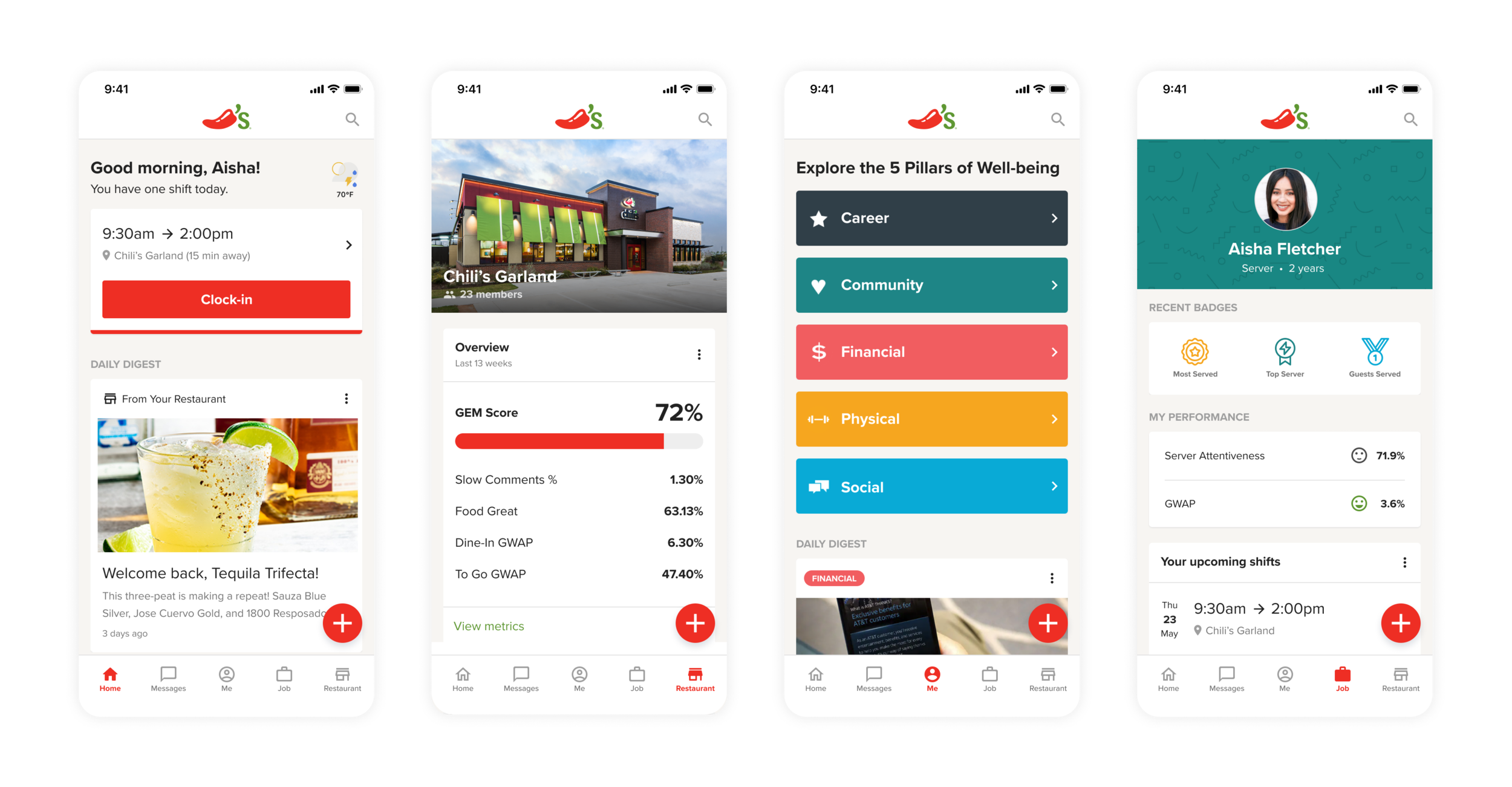Chili’s
Design Sprint, UX Design
Overview
For the last five years, Brinker International (Chili’s, Maggiano’s) has partnered with Credera to enhance their digital guest experience. One of the areas that needed improvement was around the experience for their front-of-house and back-of-house staff. We ran a design sprint to test and validate how technology could improve communication within their restaurants.
My Role
I led and facilitated a one week design sprint with the client. I worked with their team to storyboard a concept and built a clickable prototype for user testing. While members of my team ran user testing sessions within the restaurants, I used Lookback to observe and record those sessions.
Understand
The first day for us was to fundamentally understand the problem and in this case, it was to understand the relationship between 3 main personas: hourly employees, managers and what we would call Above Restaurant or really Corporate
Hourly Employees
Their main priority was to come and clock-in and clock-out. Next, it would be any menu changes or items to promote, usually communicated by Managers but not often. Everything else kind of falls to the wayside - which the team was worried led to their high attrition rate, about 48% in the first 90 days.Managers
A lot of pressure fell on Managers to communicate necessary information and make all employees feel a sense of belonging and community to the bigger brand. After interviewing stakeholders, Managers were definitely upset about the weighted pressure.Above Restaurant
This is what the Brinker team called corporate employees who would send communications to Managers and Hourly Employees. Above Restaurant employees made up of various siloed departments which led to miscommunication and redundancies. On top of that, there were various applications like ChiliChat, Medallia, HotSchedules, LINC - either bought or built to solve a sliver of the problem, but none of them adopted as a source of truth for both Managers or Employees.
problem statement
How might we increase hourly employee communication, engagement, and community at each individual Chili’s location?
Ideate
The next day, we started with Lightning Demos, which was each of us individually looking at various digital experiences similar or adjacent to the problems we were trying to solve. A few of notable digital experiences were brought up below:
Spotify - which highlights the personalization aspect and made it feel like it was part of you, that it knew you
Todoist - which did a great job organizing what items needed to get done
Hot Schedules - which is an app that many of the Chili's employees use, allows you to manage schedules for a given team
ClassDojo - this was an interesting one because there was a level of gamification that happens for each classroom that we thought maybe it would be interesting to test to see if that would increase engagement
We then spent the day looking over all the notes we took and the inspiration in front of us and separately started working on our ideas: moving from sketching to full-on wireframes.
Final Prototypes
Test
We conducted 9 user testing sessions at two different locations - 6 hourlys and 3 managers.
Overall, we heard that having one place for communication and scheduling would save them a ton of time.
Along with that, the ability to see Manager Notes before they start the shift was super helpful for both Managers and Employees.
2 hourly employees we tested with were Bartenders, and they expressed how Searching for a drink recipe would be super helpful for them.
The gamification part of the app was met with some mixed feelings
Like with most gamification, it is sometimes unclear what the motive behind earning badges really lead to.
Many of them questioned - do I get monetary rewards? Do I get time off? What's the overall point of this?
Fostering competition when competition wasn't there proved to be the challenge behind this feature.
Similarly, the news feed was received fine but many employees expressed that they probably wouldn't be spending a ton of time reading through this content. Maybe over time, they would as they get acclimated to the app, but it needs to provide relevant and useful information.
Screenshot of user testing session via Lookback
Results
Ultimately, this app never actually got built. As much as Brinker enjoyed the ideation and future state thinking, I think it was way more than they could handle at the moment. But what came out of it was key learnings about what their company should or should not invest in.
Lastly, the main takeaway that we got out of this was introducing the Design Sprint methodology for Brinker, of which I was able to conduct another one of these sessions with for them on another project.







